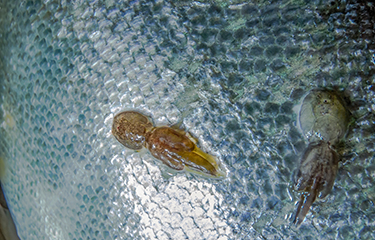A Canadian government study downplaying established links between sea lice at British Columbia’s salmon farms and wild salmon populations has drawn a strongly-worded rebuttal from a group of university professors and scientists.
The Canadian Science Advisory Secretariat (CSAS) and Fisheries and Oceans Canada (DFO) recently published a study exploring the connections between sea lice originating from Atlantic salmon farms and sea lice infestations on wild juvenile Pacific salmon. The study comes at a time when the future of salmon farming on Canada’s west coast is being debated and wild stocks are largely in decline.
The issue is seen as an important one by scientists, the salmon industry, and observers, as wild juvenile salmon infected with sea lice are said to have a decreased ability to survive in open waters.
The study sought to provide “… quantitative estimates of the association between the weekly number of farm-origin L. salmonis copepodids in the marine environment in British Columbia and their contribution to infestations on wild juvenile Pacific salmon under current farm management thresholds.”
“We saw a positive but statistically insignificant association in all four regions studied,” the study read.
That finding was seized upon by the BC Salmon Farmers Association as conclusive evidence that sea lice found on farm-raised salmon does not impact sea lice infestation levels on wild juvenile salmon.
In stark contrast, a group of academic scientists – who include researchers from major Canadian universities including the University of British Columbia, University of Toronto, Simon Fraser University, and University of Victoria – said the CSAS/DFO report suffers from “serious scientific failings,” which they outlined in a 45-page open letter to Canadian Minister of Fisheries, Oceans, and the Canadian Coast Guard Joyce Murray.
Some of the report’s deficiencies, which are expanded upon in their letter, include “selective reporting of non-significant results, improper peer review, disregard of published scientific evidence, technical flaws in the analysis, and erroneous interpretation of the report’s own statistical results.”
In the letter, the signatories said they have published over 1,500 peer-reviewed scientific papers, serve on 30 editorial boards of scientific journals, and have decades of experience in science advisory processes across levels of government.
“We note this so that it will not be taken lightly when we say that this report falls far short of the standards of credible independent peer review and publishable science,” the letter said. “Ultimately, promoting a system of evidence-based science advice that attains the highest standards of impartiality and transparency, underscored by a rigorous and independent peer review process, will build Canadians’ trust in the department and decisions surrounding controversial files, such as salmon aquaculture.”
Sean Godwin, a post-doctoral fellow at Simon Fraser University and signatory to the letter, told SeafoodSource the report’s subject matter – specifically the transmission of sea lice from farmed salmon to wild fish populations – is acknowledged broadly by scientists.
“The question the DFO asked in this report has already been answered the world over. It's not something that is really even contested by industry scientists, by people within the salmon industry” he said. “There's more than 30 peer-reviewed publications on that in B.C., and many, many more elsewhere in the world.”
Godwin added that the newest study is part …
Photo courtesy of NatureDiver/Shutterstock








